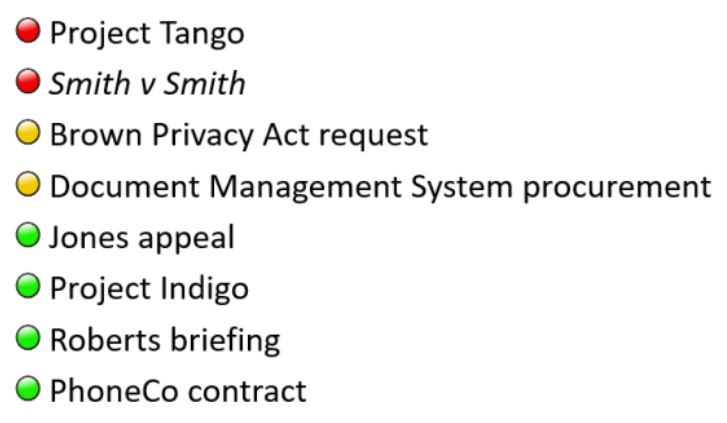It’s usually a fair assumption that a General Counsel takes an interest in the legal risks facing his or her organisation. We’ve worked with many in-house legal teams that provide risk reports to their General Counsel (who in turn may provide it to her/his Chief Executive, Executive Team or Board) based on some variant of a “traffic light” reporting system:

Great! Our General Counsel now has a list of all “important” matters. And obviously the red ones are the most important, and so require the most attention!
But why are the red issues the most important? Are they the ones with the highest legal risk? Or just the ones that have the highest level of interest? What do we even mean by legal risk? The issues that are most likely to cost us money? The court cases we’re most likely to lose? Or the ones that would have the biggest impact if we did lose?
Things like litigation, contract disputes and potential law breaches are obvious things that might make it to the red light-category. But many General Counsel also need to know about “the CEO might stop by and ask you about this”-level issues. Issues that aren’t legally “risky” per se, but have attracted attention of Someone Important and therefore also need to be on the General Counsel’s radar. Even if it is only so the General Counsel can say (in confidence) that s/he knows about the issue and that it’s under control. These issues shouldn’t be ignored, or the legal team runs the risk of making the General Counsel look just a bit foolish when asked about just such an issue. But make the list too exhaustive and you have the risk that the real issues get hidden in among all the other things on the list (the signal-to-noise ratio problem).
A simple approach we’ve used to great effect is heatmap reporting. This is a basic way of splitting out key facets of information (the hotspots), while retaining the ability to consume the information at a glance. For most legal teams, one of the most useful methods is splitting out the legal and non-legal importance of a particular matter:

At a glance, our General Counsel can now see both the legal “risk” (plotted on the x-axis) and the legal “significance” (y-axis) of any given matter. This gives her/him an overview of the individual matters that should be on her/his radar. But it also provides far more information as to why a particular matter should be on her/his radar.
The heatmap report shows that the Smith v Smith matter actually needs far more attention from the General Counsel than the Project Tango matter. Although both have similar amounts of legal risk for the organisation, one has received the internal level of escalation appropriate to it, while the other has not. Similarly, our General Counsel can see that several matters, while of particular interest to the CEO, do not carry any special legal risk.
The actual categories used in this type of heatmap reporting will inevitably vary from organisation to organisation. The risk and significance approach suggested above works for many organisations, but other categorisations (or even a z-axis if you want to get really granular and can visualise reports in 3D) might be appropriate for certain businesses. For example, a litigation-focused report might split out probability of success against consequences of failure. A cost-focused report might show matters by budget (legal or general) against risk or importance.
How?
Some practice management systems include this type of heatmap reporting out-of-the-box. Or if you’ve only got a small list of matters and are happy working manually, it’s straightforward to put together this sort of table together in a Microsoft Word or Excel table.
But if you’ve got lots of matters or are using a practice management system that doesn’t have this type of report automatically, it’s more trouble than you would think to get it automatically arranged in a heatmap format. Even though it looks like a PivotTable should work, I’ve yet to find a way to get a PivotTable to present the data the way you want without quite a bit of hacking.
The best solution we’ve found so far (please let us know if you’ve got something better) uses some VBA scripts to drive Excel macros. If you’re a power user and want to put this together yourself, please let us know and we’ll happily supply you a separate copy of the code. But if you want the hard work done for you, you can download a copy of our pre-set template HERE for free and use it however you like – instructions for use are in the first tab. Note that this does involve the use of macros, which are a known way of spreading viruses. Always download anything macro-enabled with care and in accordance with your ordinary IT policies.